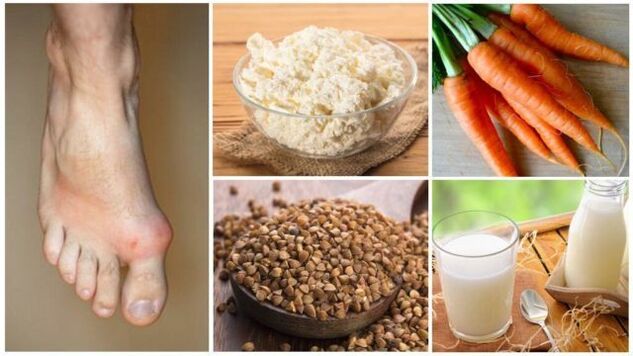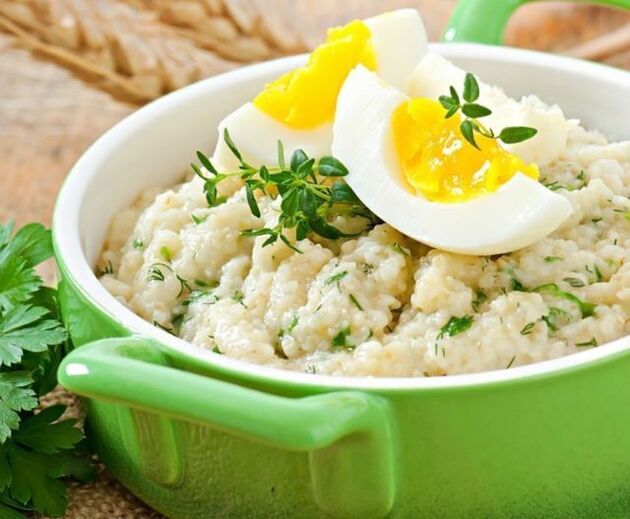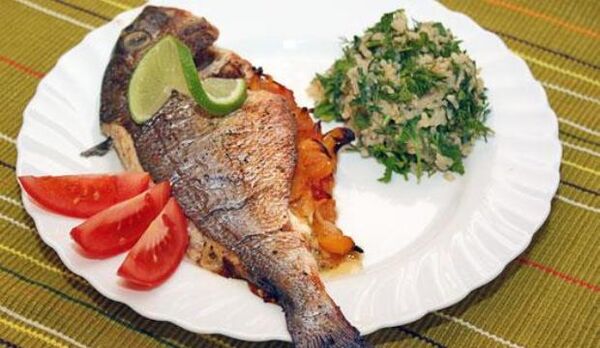
Malnutrition combined with impaired nutrient absorption leads to gout progression. The disease develops when the level of uric acid in the blood exceeds the permissible limits (for men older than 420 μmol / l, for women - 350 μmol / l). Disruption of metabolic processes results in the formation of salts of these acids on the intestinal walls, blood vessels, joint surfaces and damage important organs of human life.
Over time, the disease often recurs. In the acute period, patients experience unbearable pain at the site of the pathological process. Diet for gout helps to normalize uric acid levels and reduce the frequency of relapses.
Why follow a gout diet?
An important task of therapeutic measures is to reduce the nature and frequency of the disease. This can be achieved by reducing the amount of uric acid in the body.
The development of gout attacks is caused by:
- consume large amounts of foods high in purine substances;
- metabolic disorder.
Diet optimization allows you to start the right processes of substance uptake and excretion. Therapeutic measures to address the causes of disease development are closely related to compliance with some food dependence restrictions. With a well-designed diet menu, you can slow the progression of the disease.

Foods that make up the daily diet of humans should include foods that are high in substances that are beneficial to the body.
Dietary gout therapy is designed to reduce the symptomatic manifestations by removing the food components that provoke them. The products that a person eats on a daily basis have a huge impact on the general state of health, are responsible for the chemical processes that take place in the human body throughout his life.
What not to eat with gout?
Based on the research, the researchers established a list of products that directly cause the initial development of the disease and its further progression.
The list of things you can't eat for gout includes:
- smoked spicy cheese and cheese product;
- cholesterol-rich meat and bone products (pulp of young animals and pigs, hooves, buldyzhki);
- meat and bone fat, ears;
- fish high in fat (sardines, sprats);
- pickled vegetables, pickled fruits (cabbage, watermelons, cucumbers, apples);
- hot, cold smoked products;
- legumes (peas, beans, soybeans, lentils);
- greens containing oxalic acid (spinach leaves, sorrel, rhubarb roots);
- hot spices, sauces;
- some varieties of vegetable varieties (Brussels sprouts and cauliflower, radishes);
- internal organs of animals obtained by slaughtering meat (kidneys, liver, lungs, heart, brain);
- Oats cereals;
- confectionery fats;
- any percentage of alcohol;
- fruits and berries (grapes, raspberries, figs);
- hot, spicy and essential spices (bay leaves, horseradish, chili peppers);
- animal fats and oil products (fats, margarine, lard);
- canned meat, fish and vegetable products.

If the diet is unbalanced or contains a large amount of fatty, spicy or heavy meals for the digestive system, human metabolism may be impaired.
List of products whose use is recommended to be restricted:
- coffee, strong tea;
- butter;
- plums;
- nightshade vegetables (aubergines, tomatoes, peppers);
- table salt, granulated sugar;
- mushrooms (during remission only).
In order to alleviate the attack, as well as maintain a state of remission, it is important to eliminate these foods from the diet for a long time.
What can you eat with gout?
List of foods recommended for use in patients with this disease:
- dietary meat products (rabbits, poultry, lean beef);
- lean white fish (pike, pike, cod, pike);
- bran and rye bread;
- chicken eggs (other than yolks);
- cereal dishes (rice, wheat, buckwheat, millet, pearl barley);
- fresh vegetables (beets, carrots, cucumbers, cabbage, potatoes);
- seasonal fruits, berries (watermelon, melon, apricots, strawberries, peaches, cherries, blackberries, green apples);
- pasta;
- nut kernels (hazelnuts, walnuts, cedar);
- herbal teas and decoctions (Dubrovnik, basil, catnip);
- fermented milk products, curd;
- freshly squeezed juices, fruit drinks, compotes;
- cooked tomatoes;
- spices (turmeric, fennel, basil);
- vegetable oil (olive, rapeseed).

Dietary gout therapy will help the patient to quickly get rid of unpleasant and painful symptoms at home.
Limited amounts of natural honey are beneficial for gout. This product is suitable as a sugar substitute.
Honey has many useful properties:
- immunostimulatory;
- antioxidant;
- improvement of metabolic processes;
- bactericidal.
You should not abuse this beekeeping product during the acute period. People with this disease need to eat foods rich in vitamins, trace elements, amino acids. A useful additive is pharmaceutical fish oil for gout.
General food rules
Removing certain prohibited foods from the regular menu does not guarantee direct relief. In addition, the list of products varies according to the course and severity of the disease. Thus, gout diet during exacerbation involves adherence to stricter restrictions than during remission.

For patients with this disease, there is a common set of rules that are important in diet therapy:
- Eat food in small portions several times a day at small intervals (5-6 times). Hunger increases the amount of acetone in the urine. And this can complicate the course of the disease.
- Chew food thoroughly, do not overeat.
- Limit the amount of table salt used in cooking (up to 5 grams per day). Salt has the property of trapping fluids in the tissues, which in turn means the deposition of uric acid salts.
- Optimize your body fluid balance. To do this, it is recommended to drink at least 2 liters a day.
- Organize fasting days. Preferably vegetables, milk and fruits (except forbidden to consume).
- Adhere to restrictions for long periods of time as short-term use of a therapeutic diet is ineffective.
People suffering from severe metabolic disorders, diabetes and gout should refrain from meals that cause an increase in uric acid and insulin levels in the blood. Diet against gout and diabetes is designed to reduce these rates to prevent exacerbations and complications.
How to properly prepare food?
Restricting the list of groceries is not the only thing to follow. When preparing food, it is important to choose the right cooking method.

There are no special requirements for the preparation of the products, except for meat processing.
Cooking is allowed in the following ways:
- leeks;
- baking;
- extinguishing;
- boiling;
- stagnation.
Do not cook:
- baking;
- smoking;
- salting and marinating;
- fermentation.
Do not use stale, burnt food. The temperature regime of the food consumed should be optimal for the food and should not exceed 40 degrees. Food should not be rough and hard. If necessary, individual dishes can be shredded with a mixer.
Effective diet: a menu for every day
Medical nutrition in terms of the amount of important components (protein, carbohydrate and fat balance), calories, vitamins, trace elements, amino acids should meet the physiological needs of patients.

Approximate diet for gout and uric acid:
1 day
First breakfast: boiled cod, mashed potatoes, black bread, white cabbage salad flavored with sour cream, a cup of light coffee with saccharin.
Second breakfast: curd stew, boiled egg, bran bread, tea drink.
For lunch: vegetarian soup with fried roots and potatoes, beef stew, buckwheat porridge, fresh cucumber, 1 apple.
Dinner: carrot cutlets, pasta, milk, biscuit cookies.
At night: 200 ml of kefir.
Day 2
First breakfast: stewed white cabbage, 1 boiled egg, black bread, cappuccino.
Second breakfast: cappuccino, biscuit cookies.
For lunch: lean borscht, bran bread, fried poultry fillet, boiled rice, fruit jelly.
For dinner: stewed potatoes with vegetables, vegetable stew, bran bread with butter, a glass of broth.
At night: 250 ml of curdled milk.

Day 3
First breakfast: vegetable salad (white cabbage, carrots, apples), light coffee.
Second breakfast: cottage cheese with sour cream, rosehip broth.
For lunch: barley soup with sour cream, steam cutlet, mashed potatoes, berry jelly, whole grain bread.
For dinner: carrot cutlets with fruit, semolina stew, glass of milk.
Before bed: steamed prunes.
Day 4
First breakfast: grated carrots with sour cream, wheat porridge, a glass of green tea.
Second breakfast: dried fruit cutlets, compote, biscuit cookies.
For lunch: milk pasta, boiled chicken with fried pumpkin and potatoes, fruit jelly, black bread.
For dinner: baked cheesecakes in the oven, carrot and apple cutlets, a glass of tea with lemon.
At night: 200 ml of warm milk.
Day 5
First breakfast: porridge cooked in buckwheat milk, green tea.
Second breakfast: a glass of fresh carrots.
For lunch: vegetable rice soup with sour cream, boiled beef pulp, beetroot caviar, basil infusion with honey, black bread.
For dinner: pumpkin stew with sour cream, a glass of weak tea, crackers.
Before bed: Rosehips are poured with honey.
Day 6
First breakfast: chicken protein omelette, stewed beets, white bread, a glass of weak coffee.
Second breakfast: zucchini stew, fruit and berry compote.
Lunch: vegetarian barley soup, boiled potatoes, stewed meatballs, jelly, black bread.
Dinner: Rice cooked in milk, weak tea drink.
Before bed: a glass of yogurt.
A standard diet is prepared by your doctor. The options for combining dietary foods are varied. Diet no. 6 characteristic of gout. Its main principle is the exclusion of foods and dishes rich in purine, the inclusion of alkaline beverages in the diet and gentle processing during cooking. An independently compiled menu with a restriction on the amount and nature of food can lead to a prolonged course of the disease.
















































































